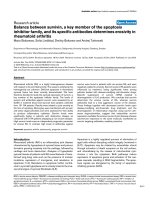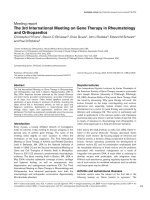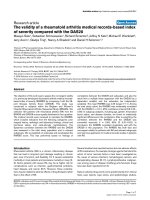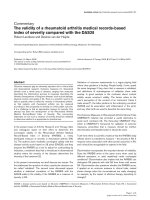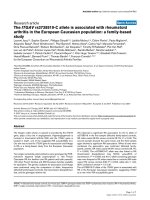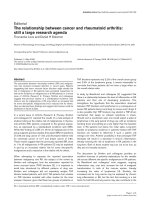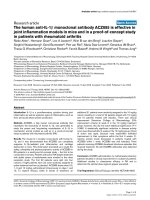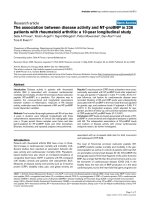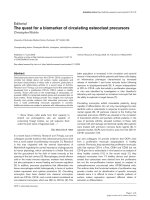Báo cáo y học: "The rheumatoid foot: a systematic literature review of patient-reported outcome measures" pot
Bạn đang xem bản rút gọn của tài liệu. Xem và tải ngay bản đầy đủ của tài liệu tại đây (485.28 KB, 8 trang )
REVIE W Open Access
The rheumatoid foot: a systematic literature
review of patient-reported outcome measures
Steven Walmsley
1*
, Anita E Williams
1
, Mike Ravey
2
, Andrea Graham
1
Abstract
Background: The foot is often the first area of the body to be systematically affected by rheumatoid arthritis. The
multidimensional consequences of foot problems for patients can be subjectively evaluated using patient-reported
outcome measures (PROMs). However, there is currently no systematic revi ew which has focused specifically upon
the PROMs available for the foot with rheumatoid arthritis. The aim of this systematic review was to appraise the
foot-specific PROMs available for the assessment and/or evaluation of the foot affected with rheumatoid arthritis.
Methods: A systematic search of databases was conducted according to pre-defined inclusion/exclusion criteria.
PROMs identified were reviewed in terms of: conceptual bases, quality of construction, measurement aims and
evidence to support their measurement properties.
Results: A total of 11 PROMs were identified and 5 papers that provided evidence for the measurement properties
of some of the PROMs. Only one of the PROMs was found to be RA disease-specific. The quality of construction,
pretesting and presence of evidence for their measurement properties was found to be highly variable. Conceptual
bases of many of the PROMs was either restricted or based on reductionist biomedical models. All of the PROMs
were found to consist of fixed scales.
Conclusions: There is a need to develop an RA-disease and foot-specific PROM with a greater emphasis on a
biopsychosocial conceptual basis, cognitive pre-testing methods, patient preference-based qualities and evidence
to support the full complement of measurement properties.
Background
The foot is often the first area of the body to be system-
atically affected by rheumatoid arthritis (RA) [1,2]. Upon
diagnosis, approximately 16% of patients with RA have
foot involvement [3], i n 15% of cases the forefoot is the
first area of the body to become sympt omatic [4], and
virtually 100% of patients report foot problems within
10 years of RA o nset [5]. These clinical foot problems
have a significant effect on the person’s functional ability
which is known to lead to important emotional experi-
ences for patients, including anger and sadness [6].
The m ultidimensional consequences of fo ot problems
can be subjectively assessed and evaluated using patient-
reported outcome measures (PROMs). PROMs record
patients’ pe rspectives of their health, illnesses and the
impact of any clinical interventions in a valid, reliable
and feasible way [7]. They are an objective means of
recording largely subjective outcomes and represent an
ideal, economical and efficient method of measur ing the
quality and efficacy of care provided [8], integrating
important psychosocial factors into a clinical assessment
that otherwise may not be gathered.
According to Bowling [9], PROMs can be charac-
terised in terms of their disease specif icity (generic or
non-disease specific), measurement objectives (discrimi-
nat ion, evaluation and prediction) and what they inten d
to measure (quality of life, health related quality of life
(HrQoL) or health status).
The development of a PROM and establishment of its
measurement properties most commonly entails the use
of psychometric theory, which can be divided into two
main methodological approaches: C lassical Test Theory
(CTT) and Item Response Theory (IRT) [10]. CTT
(referred to as Traditional Psychometrics) utilises both
item and sample statistics and is based upon 3 concepts,
together known as True Score Theory [11]: test /observed
* Correspondence:
1
Directorate of Prosthetics, Orthotics and Podiatry and Centre for
Rehabilitation and Human Performance Research, University of Salford,
Greater Manchester, UK
Walmsley et al. Journal of Foot and Ankle Research 2010, 3:12
/>JOURNAL OF FOOT
AND ANKLE RESEARCH
© 2010 Walmsley et al; licensee BioMed Central Ltd. This is an Open Access article distributed under the terms of the Creative
Commons Attribution License ( whic h permits unrestricted use, distribution, and
reproduction in any me dium, provided the original work is properly cited.
score, true score and error score. Item response theory
(known as Modern Psychometrics), on the other hand,
utilises logistic response models to apportion individual
items to the constructs of interest using conditio nal
methods, according to their individual difficulty and the
ability of subjects to respond positively to the items [12].
In selecting a PROM for use in either a clinical or
research environment, the decision should be made
upon its conceptual basis [13], the appropriateness of
the PROM for the intended purpose and evidence for
its measurement properties [14] (see Additional File 1,
Table 1). A conceptual basis/model for a PROM is
required to establish a well-defended rationale for and
specify clearly the outcomes of interest for the instru-
ment. The la ck of an appropriate conceptual model for
a PROM can result in a number of problems, including
weak or incorrect scoring, anal ysis and i nterpretation of
the data yielded [13].
Given the impact of foot problems for the adult with
RA and t he recognition that foot health interventions
are an important aspect of health care for this patient
group [15], a measurement of changes in foot health is
vital to the monitoring of the foot and interventions for
it from both the clini cian’s and the patient’s perspective.
This notion aligns with Darzi [16] who has recom-
mended the use of PROMs, which focus on quality
health care from a patient-centred perspective.
There are systematic reviews of PROMs for the foot
and ankle in general [17] and for combined objective
and subjective outcome measures, which incl udes a nar-
row selection of PROMs, with application for the foot
with RA [18]. However, currently, there is no systematic
review that has appraised specifically and in detail
PROMs relevant for the foot with RA in terms of t heir
conceptual bases, quality of construction and evidence
for their measurement properties. Therefore, a systema-
tic review of PROMs with relevance to the foot with RA
is both timely and appropriate.
The aim of this systematic review was to appraise the
quality of PROMs that may be used for the assessment
and evaluation of the foot with RA in terms of their
conceptual bases, quality of their construction, measure-
ment aims and evidence for their measurement
properties.
Methods
This review was conducted using appropriate systematic
review methods and is reported in accordance with the
PRISMA statement [19]. A structured and exhaustive
search of Pubmed, Embase, Cinahl, Ingenta, Science Direct
and the Cochrane Collaboration Library was conducted on
15/10/2008 using the search terms: ‘Rheumatoid arthritis’
and ‘foot index,’‘foot score,’‘foot instrument’ and ‘foot
evaluation’. The search was restricted to publications in
the English language. The reference lists of journal articles
of interest were also searched and no restriction on year of
publication was imposed to reduce publication bias.
PROMS s elected for the review fulfilled the following
inclusion criteria:
• Foot region specificity.
• Measurement of constructs relevant to the foot
with RA, such as pain or activity limitation.
• Potential for application of the PROM in a
research and/or clinical environment.
An additional search for specific evidence for the mea-
surement properties of the PROMs was conducted by
using the same search strategy, using the name of the
PROM and ‘measurement properties,’‘reliability,’‘valid-
ity,’‘validation,’‘responsiveness’ and ‘interpretability’ as
search terms.
All PROMs included in the review were appraised
according to several pre-defined quality assessment cri-
teria, including: The Scientific Advisory Co mmittee of
the Medical Outcomes Trust [20], The Patient-Reported
Health Instruments Group [21] and the NHS Technol-
ogy Assessment Board [7].
Results
Eleven PROMs were found to be eligible for inclusion in
this review (Figure 1). Five papers that contributed evi-
dence for the measurement properties for some of t he
11 PROMs were identified and also included in this
review. Of the 11 PROMs identified, 7 of them were
judged to be non-disease specific and based upon CTT,
2 of them non-disease specific and based upon IRT; one
was juvenile idiopathic arthritis (JIA) disease-specific
and based upon CTT; and one was RA d isease-specific
and based upon IRT. Therefore, the papers were subdi-
vided into 4 sub-groups according to these difference s
and reviewed accordingly.
Non-disease specific PROMs (Classical Test Theory-based)
The Foot Function Index (FFI)
The Foot Function Index [22] is an evaluative PROM
providing a measure of pain and disability, over a time
period of one week, arising from joint diseases asso-
ciated with older populations (See Additional File 1,
Table 2). It is based u pon the conceptual hypothesis
that pain and activity limitation are the main complaints
associated with musculoskeletal problems of the foot.
However, the PROM does not evaluate other valid and
equally important potential constructs, such as footwear,
participation restriction [6,23] and other biopsychosocial
fact ors associated with chroni c pain and reflected in the
International Classification for Functioning, Disability
and Health (ICF) [24].
Walmsley et al. Journal of Foot and Ankle Research 2010, 3:12
/>Page 2 of 8
Content generation for the PROM did not include
patients as recommended by Rattray and Jones [25] sug-
gesting poor evidence for content validity. The FFI has
evidence for a number of measurement properties (See
Additional File 1, Table 3), including responsiveness
[26,27] and sensitivity.
The Manchester Foot Pain and Disability Questionnaire
(MFPDQ)
The Manchester Foot Pain and Disability Questionnaire
[28] is an evaluative and discriminative PROM (See
Additional File 1, Table 2) for identifying levels of foot
pain and disability over the past month. However, with
a conceptual basis that includes assessing foot pain and
disability in terms of only the 3 constructs of pain inten-
sity, activity limitation and personal appearance, the
MFPDQ may not adequately capture the psychosocial
experiences of patients arising from pain and disability
in their feet [29]. Only 1 item is dedicated to the rela ted
issue of footwear.
Content genera tion for the MFPDQ entail ed open
interviews with patients with foot-related pain, disability,
activity limitation and footwear problems, ensuring con-
tent validity. Proof to support the measurement proper-
ties of the MFPDQ is limited (See Additional File 1,
Table 3).
The Podiatry Health Questionnaire (PHQ)
The Podiatry Health Questionnaire [30] is a discrimina-
tive and evaluative PROM (See Additional File 1, Table
2), for the assessment of foot-related HrQoL of podiatry
patients with a range of foot conditions and the effec-
tiveness of foot interventions over no specific time
frame. Although the 7 constructs that form the concep-
tual framework of the PROM appear to be eclectic, each
is represented only by one item, restricting the amount
of information that can be gathered for each construct
and increasing the potential for measurement error [31].
The PHQ has no evidence to support any of the mea-
surement properties (See Additional File 1, Table 3).
The Bristol Foot Score (BFS)
The Bristol Foot Score (BFS) is an evaluative and discri-
minative PROM [32] that assesses the impact of foot
problems on everyday life from the patient’s perspective
over 2 weeks, in terms of HrQoL (See Additional File 1,
Table2).TheconstructsmeasuredbytheBFScanbe
considered to provide a reasonably comprehensive cov-
erage of HrQoL [33].
Content for the BFS was generated through interviews
with patients with a wide range of conditions, such as
RA, diabetes and oste oa rthrit is, ensuring that the items
are highly r elevant to patients and providing evidence
Figure 1 Papers screened, identified and selected for review.
Walmsley et al. Journal of Foot and Ankle Research 2010, 3:12
/>Page 3 of 8
for content validity. However, no experts were involved
or a literature s urvey carried out, potentially restricting
the breadth of content o f the items generated [12].
There is no evidence available to support the majority
of measurement properties for the PROM (See Addi-
tional File 1, Table 3).
The Foot Health Status Questionnaire (FHSQ)
The Foot Health Status Questionnaire is an evaluative
and discriminative PROM [34] initially developed to have
good clinical utility and psychometric soundness for the
assessment of foot health status of patients both pre- and
post-surgery (See Additional File 1, Table 2), over a per-
iod of one week. It was later recommended suitable for
the assessment of general foot health status and the effi-
cacy of non-surgical interventions. The four constructs
measured by the FHSQ can be considered almost fully
representative of the concept of health status [33].
Furthermore, the addition of a footwear subscale to the
PROM helps to ensure comprehensive coverage of health
status issues in relation to musculoskeletal conditions.
Content generation involved an unspecified number of
focus groups with experts only, suggesting restricted
content validity. The FHSQ has evidence for the major-
ity of measurement properties (See Additional File 1,
Table 3), including responsiveness [27] and clinical
interpretability [35].
American Academy of Orthopaedic Surgeons Lower Limb
Outcomes Assessment Instruments: Foot and Ankle Module
(FAM)
The a im of the FAM [36] was to standardise treatment
outcomes for various musculoskeletal conditions (ran-
ging from acute trauma to chronic diseases such as RA)
with respect to evaluation of symptoms from the
patient’s perspective. It is comprised of two individual
scales: The Global Foot and Ankle Scale (GFAS), which
refers to the past two weeks, and the Shoe Comfort
Scale (SCS), which refers to no particular time frame
(See Additional File 1, Table 2).
The constructs a ssessed by both the SCS and GFAS
may be considered restricted for the purposes of the
PROM. With a conceptual basis that considers only
structure and function, the GFAS does not consider
relevant concepts such as health status and HrQoL and
thus the impact of mu sculoskeletal foot conditions from
a biopsychosocial perspective. With respect to the SCS,
the items are dedicated only as to whether patients can
wear different types of footwear, not a subjective evalua-
tion as to whether their footwear is deemed comfortable
or not. A study comparing patient perceptions of foot-
wear fo r patients with either RA or diabetes, [37]
demonstrated that footwear comfort and appearance are
particularly important to patients with RA.
Content generation for the FAM did not involve inter-
views with patients, potentially restricting content validity
[38]. Further to this, it lacks evidence to support the
majority of measurement properties, with the exception
of clinical interpretability [39], internal consistency and
test-retest reliability, face validity and clinician feasibility
(See Additional File 1, Table 3).
The Rowan Foot Pain Assessment Questionnaire (ROFPAQ)
The Rowan Foot Pain Assessment Questionnaire [40],
represents an attempt to provide a PROM that evaluates
the multidimensional aspects of chronic foot pain over
no specific time period (See Additional File 1, Table 2).
It was developed with reference to the Gate Control
Theory of Pain [41]. Conceptually, the ROFPAQ ma y be
considered too restricted as concepts such as HrQoL,
health status, and patient experiences of chronic disease
span far beyond pain [42].
Content generation for the ROFPAQ entailed 6 focus
groups and 2 semi-structured interviews with patients,
ensuring good evidence of content validity, and the
PROM has evidence to support many of the measure-
ment properties (See Additional File 1, Table 3).
Disease-specific PROM (Classical Test Theory-based)
The Juvenile Arthritis Foot Disability Index (JAFI)
The Juvenile Arthriti s Foot Disability Index [43] is an
evaluative and discriminative PROM. It was designed for
the assessment o f foot-related disability in children and
adolescents with juvenile idiopathic arthritis (juvenile
RA) in terms of severity and the effectiveness of inter-
ventions, for a period of one week (See Additional File
1, Table 4).
The authors ensured a good conceptual basis by struc-
turing the subscales of the PROM according to the ICF
[44]. However, with only 1 item enquiring about the
availability of shoes, the authors greatly under-represent
the importance of footwear [45]. Content generation for
the JAFI involved two experts and review of the items
present in the FFI [22] and Sundbom Arthritis Foot Eva-
luation Index (SAFE) [46]. However, the SAFE has not
undergonevalidation,andtheuseofonly2expertsin
generating content for the JAFI does not suggest evi-
dence for content v alidity. The J AFI has very limited
evidence to support its measurement properties (See
Additional File 1, Table 5).
Non-disease specific PROMs (Item Response Theory-based)
The Revised Foot Function Index The Revised Foot
Function Index (FFI-R) was developed b y Budiman-Mak
et al [47] to address their perceived limitations of the ori-
ginal FFI [22] and exists in both a long (FFI-RL)
and short (FFI-RS) form format (See Additional File 1,
Table 4). Development of the FFI-R was allied closely
with the ICF [44] and the authors acknowledged
the importance of footwear, generating 10 items dedi-
cated to the issue in terms o f pain, function and psycho-
social consequences. Thus, conceptually, the FFI-R can
Walmsley et al. Journal of Foot and Ankle Research 2010, 3:12
/>Page 4 of 8
be considered a reasonably comprehensive measure of
foot HrQoL [29]. Although content generation for the
FFI-R was varied in approach, no patients were directly
involved in the item generation process, potentiall y
restricting content validity [25].
The FFI-R was developed using a 1-parameter IRT
model, known as the Andrich Rating Scale (ARS) model
[47], for item reduction and establishment of the sub-
scales of the FFI-RL. In order for the (sub) scales of a
PROM to be fitted to a 1-parameter model, it is impera-
tive that the (sub) scales fitted can demonstrate uni-
dimensi onality and item local independence [48]. There
wasnoevidencetodemonstratethesepre-requisite
properties, suggesting that the FFI-R was not success-
fully fitted to the ARS. Both the FFI-RS and FFI-RL
have no evidence to support measurement properties
other than for face and content validity (See Additional
File 1, Table 5)
The Foot and Ankle Ability Measure (FAAM) The
Foot and Ankle Ability Measure [49] is an evaluative and
discriminative PROM developed to permit the assess-
ment of individuals with a wide range of musculoskeletal
conditions affecting their foot, ankle and lower limb in
terms of physical performance (See Additional File 1,
Table 4), over a week. The conceptual basis of the FAAM
is based solely on the structure and function component
of the ICF [44], and thus there is no acknowledgement of
the importance of biopsychosocial factors within the ICF
[50]. Content generation for the FAA M entailed review
of the literature of musculoskeletal conditions of the foot
and lower limb, followed by consultation with both
experts and patients regarding important items to con-
sider, which suggests good content validity.
Both the subscales of the FAAM were fitted to a 2-
parame ter IRT model (Bond and Fox, 2007). Procedur es
were implemented to ensure that the FAAM subscales
demonstrated the necessary conditions of uni-d imen-
sionality and item independence. The FAAM has evi-
dence for the vast majority of measurement properties
[51] (See Additional File 1, Table 5).
Disease-specific PROM (Item Response Theory-based)
Leeds Foot Impact Scale (LFIS) The Leeds Foot Impact
Scale [52] is an evaluative and discriminative PROM
developed specifically to assess the foot with RA (See
Additional File 1, Table 4) with demonstrable measure-
ment properties and wide appl icability for the evaluation
of the effectiveness of foot health interventions, in both
research and clinical environments. T he constructs
assessed by the LFIS are closely associated with the
domains of the ICF [44], creating a strong conceptual
basis, and a strong emphasis is placed upon the impor-
tance of footwear. The PROM focuses upon the qualita-
tive aspects of pain, stiffness and biopsychosocial
experiences arising from the foot with RA, including
items that allow patients to convey associated feelings of
depression, anxiety and social isolation. Content genera-
tion for the LFIS involved semi-structured interviews
with 30 patients to ensure content validity.
The authors used a dichotomous IRT (Rasch) model
[48], but no procedures were employed to ensure the
condition of unidimensionality of the both subscales of
the PROM prior to fitting, which is strongly recom-
mended [48,53]. Moreover, the items for impairments
and shoes/footwear, and for activities and participation
are merged together resulting in the two subscales for
the LFIS. The authors then claim to have successfull y
fitted these to the Rasch model. However, attempting to
fit scales that measure multiple constructs violates the
uni-dimensional assumptions necessary for ensuring
that data fit to a Rasch model. This confuses the traits
that the PROM is trying to measure and, ultimately,
what the scores represent [48].
The LFIS has evidence to support some of its mea-
surement properties (See Additional File 1, Table 5).
Discussion
This systematic review identified 11 PROMs with poten-
tial application f or the assessment and/or evaluation of
the foot with RA, 9 of which are based on CTT and 3
on IRT. However, only 1 of the PROMs is RA disease-
specific, 1 JIA disease specific and the other 8 are gen-
eric. For the assessment and evaluation of a specific dis-
ease condition, generic PROMs may lack sufficient
levels of validity, responsiveness and sensitivity [12].
All of the PROMs vary in terms of the conceptual bases
for their development, quality of the methodological pro-
cedures used for their development (item generation,
selection and appraisal) and the amount of evidence
available to support their measurement properties. In
terms of their conceptual bases, only 5 of the PROMs
identi fied can be considered to evaluate or assess muscu-
loskeletal conditions of the foot from a biopsychosocial
perspective [22,32,34,43,52], one of them is RA disease-
specific [52] and the other JIA disease-specific [43]. The
other PROMs identified are formulated on conceptual
bases that are either very restricted, such as the ROFPAQ
[40] with the sole assessment of pain, or rooted in reduc-
tionist biomedical models of disease, such as the FAM
[36] with its strong emphasis on structure and function.
Biomedical models, such as the Inter national Classifi-
cation for Impairments, Disability and Handicaps [54],
assume a linear progression from a health condition to
impairme nts and disability [55] and do not take account
of the bi-directional implications of environmental or
personal factors, leading to an over-simplistic appraisal
of the implications of chronic diseases for patients [56].
PROMs that use biomedical models their conceptual
bases may lack a wide e nough conceptual scope to
Walmsley et al. Journal of Foot and Ankle Research 2010, 3:12
/>Page 5 of 8
comprehensively evaluate the impact of chronic condi-
tions on feet, such as RA. Furthermore, only 5 of the
PROMs identified [32,34,36,47,52] consider the implica-
tions of footwear for patients with musculoskeletal con-
ditions of th eir feet, with only one of them RA disease-
specific. Given the importance of footwear for the man-
agement of musculoskeletal conditions of the foot [57],
particularly RA [15,58,59], it is an important omission.
The content generation methods employed for the
development of each of the PROMs vary in terms of both
approaches and quality. R attray and Jones [25] argue that
the generation of content for PROMs should entail a vari-
ety of sources, particularly the engagement of patients, to
ensure that the items generated have content validity and
are as relevant to patients as possible. Although many
PROMs employed heterogeneous content generation
methods, only 4 PROMs identified [28,32,40,52] use d
interviews with patients. It is known that patient and clini-
cian perspectives of what is important are different
[60,61], so those PROMS relying on experts only to gener-
ate content may have restricted relevance to patients.
Levels of pre-testing of the PROMs appears highly vari-
able and, in some cases, absent from the methodological
approaches used to develop them. Pre-testing of PROMs
is necessary to ensure that all of the questions are consis-
tently easy to read and understand by all respondents.
This is to reduce measurement error a nd non-response
by achieving what Groves and colleagues [62] suggest to
be content, cognitive and usability standards. Such stan-
dards can be evaluated during the pre-testing phase via
expert reviews, f ocus group discussions, cogn itive inter-
views and field pre-testing [63]. Although many of the
PROMs involved pre-testing of their c ontent in terms of
their content standards and usability s tandards, such as
the FAM [36] and BFS [32], none of the PROMs involved
pre-testing to ensure that they satisfy cognitive standards.
This is evidenced by the FAAM [49] and LFIS [52],
which feature questions containing complex terminology
and potentially distressing words, respectively.
Evidence for the measurement properties of the
PROMs is highly variable. Either no attempt has been
made to establish evidence for a particular measurement
property or procedures have been employed to demon-
strate particular measurement properties that are incor-
rect or inappropriate. Fur thermore, when considering
the evidence for the measurement properties of PROMs
based upon CTT, it should be realised that the proce-
dures involved are both sample and context-dependent.
This means that the evidence for the measurement
properties has restricted validity for use on populations
that differ from those used to develop evidence for the
PROM. As most of t he generic CTT-based PROMs did
not include patients with RA in the development of
their measurement properties, it can be considered that
they have limited clinical and research utility for the
assessment and evaluation of patients with feet with RA.
All of the PROMs identified consist of fixed scales, pre-
senti ng every patient with the same set of items irrespec-
tive of their RA disease duration, severity and particular
lifestyle. However, patients are influenced by the symp-
toms of RA to varying extents, depending upon the level
of disease activity and duration [60] and environmental
and patient characteristics [64]. Thus, a PROM consisting
of fixed items that assume equal importance and rele-
vance for every patient may not be the most appropriate
or patient-centred means of assessing the impact of foot
problems on people with RA. Although measuring the
same outcomes for groups of patients may be advanta-
geous and necessary for research such as clinical trials,
for informing decision making in clinical practice, assess-
ment of change unique to the individual has been consid-
ered to be more beneficial [65]. This is p ossible through
the use of patient preference-based questionnaires, which
are geared towards the assessment of the specific indivi-
dual and can permit the measurement of concepts such
as individual health-related quality of life [66].
Patient preference-based questionnaires have been
implemented and are currently used with considerable
success [67]. These include the Patient Generated Index
[68] and the MacMaster-Toronto Arthritis Patient Prefer-
ence Questionnaire [69]. However, this systematic review
could not identify RA or generic foot-specific idiographic
PROMs with either the potential for use in the assessment
of the foot with RA, or with any relevance to the foot.
Although this review has attempted to present a com-
prehensive appraisal and review of all foot-specific
PROMs that are relevant for the assessment and/or eva-
luation of the foot with RA in both research and clinical
environments, i t should be realised that new PROMs
may have been developed or additional evidence for the
measurement of existing PROMs presented since the lit-
erature search for this review was conducted, Further, it
was not possible to present the results of the literature
search to experts and special interest groups to gauge
its comprehensiveness prior to conducting the review.
However, the findings have been scrutin ised for accu-
racy and releva ncy by two academic podiatrists and one
independent academic. Despite this slight weakness in
approach, this review has attempted to present a com-
prehensive appraisal and review of all foot-specific
PROMs that a re relevant for the assessment of the foot
with RA in both research and clinical environments.
Conclusions
PROMs should be embedded in the ethos of patient-
centred quality health care [15]. Due to the impact of
foot problems in patients with RA on HrQol, it is vital
that a PROM is developed for the assessment and
Walmsley et al. Journal of Foot and Ankle Research 2010, 3:12
/>Page 6 of 8
evaluation of the foot with RA that has a conceptual
basis based upon the WHO [44] biopsychosocial model
of chronic diseases. Further to this, it should be ade-
quately pre-tested, have evidence to support all of the
measurement properties and feature the capacity for
patient preference-based assessment.
Additional material
Additional file 1: Tables 1-5. Table 1: Measurement properties required
for descriptive and evaluative PROMs. Table 2: Description of
development and content of Classical Test-Theory-based, generic, foot-
specific PROMS. Table 3: Evidence for the scientific measurement
properties of the CTT - based, generic, foot specific PROMs. Table 4:
Description of development and content of Classical Test Theory and
Item Response Theory-based, JIA diseasespecific, RA disease-specific and
generic foot-specific PROMs. Table 5. Evidence for the measurement
properties of the Classical Test Theory and Item Response. Theory-based,
generic andJIA disease-specific and RA disease-specific, foot - specific
PROMs.
Acknowledgements
SW would like to thank Professor Chris Nester for his helpful comments and
suggestions on previous drafts of this systematic review.
Author details
1
Directorate of Prosthetics, Orthotics and Podiatry and Centre for
Rehabilitation and Human Performance Research, University of Salford,
Greater Manchester, UK.
2
Centre for Nursing, Midwifery and Collaborative
Research, University of Salford, Greater Manchester, UK.
Authors’ contributions
SW conceived the study design, conducted the systematic review,
interpreted the findings and drafted the manuscript. AEW, MR and AG
reviewed the manuscript and provided academic support throughout. All
authors read and approved the final manuscript.
Competing interests
The authors declare that they have no competing interests.
Received: 19 March 2010 Accepted: 9 July 2010 Published: 9 July 2010
References
1. Grondal LB, Tengstrand , Nordmark B, Wretenberg P, Stark A: The foot: still
the most important reason for walking incapacity in rheumatoid
arthritis: Distribution of symptomatic joints in 1,000 RA patients. Acta
Orthopaedica 2008, 79(2):257-261.
2. Otter S, Springett K, Lucas K, Moore A, Horne R, Davies K, Young A: The
role of outcome measures in assessing change in the at-risk rheumatoid
foot. Jof Tissue Viability 2004, 14(4):137-41.
3. MacSween A, Brydson GJ, Hamilton J: The effect of custom moulded ethyl
vinyl acetate foot orthoses on the gait of patients with rheumatoid
arthritis. The Foot 1999, 9:128-33.
4. Rojas-Villarraga A, Bayona J, Zuluaga N, Mejia S, Hincapie M-E, Anaya JM:
The impact of rheumatoid foot on disability in Columbian patients with
rheumatoid arthritis. BMC Musculoskelet Disord 2009, 10:67.
5. Shi K, Tomita T, Hayashida K, Owaki H, Ochi T: Foot deformities in
rheumatoid arthritis and relevance of disease severity. J Rheumatol 2000,
27(1):84-9.
6. Williams AE, Nester CJ, Ravey M: A qualitative investigation of rheumatoid
arthritis patients’ experiences of therapeutic footwear - a qualitative
investigation. BMC Musculoskelet Disord 2007, 8:104.
7. Fitzpatrick R, Davey C, Buxton MJ, Jones DR: Evaluating patient-based
outcome measures for use in clinical trials. Health Technol Assess 1998,
2(14).
8. Fung C, Hays R: Prospects and challenges in using patient-reported
outcomes in clinical practice. Quality Life Res 2008, 17(10):1297-1302.
9. Bowling A: Measuring Disease: A Review of Disease-Specific Quality of
Life Measurement Scales. Open University Press: Buckingham, 2 2001,
25-26.
10. Streiner DL, Norman GR: Health Measurement Scales: A Practical Guide to
their Development and Use. Oxford University Press: Oxford, 3 2003,
181-187.
11. Hambleton RK, Jones RW: An NCME instructional module on comparison
of classical test theory and item response theory and their applications
to test development. Educ Meas 1993, 12(3):38-47.
12. Fayers PM, Machin D: Quality of Life. John Wiley and Sons, Ltd: West
Sussex, 2 2007, 161-176.
13. Rothman ML, Beltron P, Cappelleri JC, Lipscomb J, Techendorf B: Patient-
reported outcomes: conceptual Issues. Value Health 2007, 10(S2):S66-S75.
14. Haywood KL: Patient-reported outcome I: measuring what matters in
musculoskeletal care. Musculoskeletal Care 2006, 4(4):187-203.
15. National Institute for Clinical Excellence: Rheumatoid Arthritis: The
Management of Rheumatoid Arthritis in Adults. NICE: London 2009.
16. Department of Health:
High Quality Care for All. NHS Next Stage Review
Final Report TSO: London 2008.
17. Martin RL, Irrgang JJ: A survey of self-reported outcome instruments for
the foot and ankle. J Orthop Sports Phys Ther 2007, 37(2):72-84.
18. Van der Leeden M, Steultjens MP, Terwee CB, Rosenbaum D, Turner D,
Woodburn J, Dekker J: A systematic review of instruments measuring
foot function, foot pain, and foot-related disability in patients with
rheumatoid arthritis. Arthritis Care Res 2008, 59(9):1257-1269.
19. Liberati A, Altman DG, Tetzlaff J, Mulrow C, Getzsche PC, Ionnidis JPA,
Clarke M, Devereaux PJ, Kleijnen J, Mohoer D: The PRISMA statement for
Reporting Systematic Reviews and Meta-Analyses of Studies that
Evaluate Health Care Interventions: Exploration and Elaboration. PLoS
Med 6(7):e1000100.
20. Lohr KN: Assessing health status and quality-of-life instruments:
Attributes and review criteria. Quality Life Res 2009, 11(3):193-205.
21. Haywood KL: Patient-reported outcome II: selecting appropriate
measures for musculoskeletal care. Musculoskeletal Care 2007, 5(2):72-90.
22. Budiman-Mak E, Conrad KJ, Roach KE: The Foot Function Index: a measure
of foot pain and disability. Journal Clin Epidemiol 1991, 44(6):561-70.
23. Fransen M, Edmonds J: Off the Shelf orthopaedic footwear for people
with rheumatoid arthritis. Arthritis Care Res 1997, 10:250-6.
24. Cieza A, Stucki G: Content comparison of health-related quality of life
(HRQOL) instruments based on the international classification of
functioning, disability and health (ICF). Quality Life Res 2005,
14(5):1225-1237.
25. Rattray J, Jones MC: Essential elements of questionnaire design and
development. J Clin Nurs 2007, 16(2):234-243.
26. Soohoo NF, Vyas R, Samimi D: Responsiveness of the Foot Function
Index, AOFAS Clinical Rating Systems, and the SF-36 after foot and
ankle surgery. Foot Ankle Int 2006, 27(11):930-934.
27. Landorf KB, Radford JA: Minimal important difference: Values for the Foot
Health Status Questionnaire, Foot Function Index and Visual Analogue
Scale. The Foot 2008, 18(1):15-19.
28. Garrow AP, Papageorgiou AC, Silman AJ, Thomas E, Jayson MI,
Macfarlane GJ: Development and validation of a questionnaire to assess
disabling foot pain. Pain 2000, 85(1-2):107-113.
29. Helliwell P, Woodburn J, Redmond A, Turner DE, Davys H: The Foot and
Ankle in Rheumatoid Arthritis: A Comprehensive Guide. Churchill
Livingstone: London 2007.
30. Macran S, Kind P, Collingwood J, Hull R, McDonald I, Parkinson L:
Evaluating podiatry services: Testing a treatment specific measure of
health status. Quality Life Res
2003, 12(2):177-188.
31. Kline P: A Psychometrics Primer. Free Association Books: New York 2000,
53-64.
32. Barnett S, Campbell R, Harvey I: The Bristol Foot Score: developing a
patient-based foot-health measure. Journal of the American Podiatric
Medical Association 2005, 95(3):264-72.
33. Tully MP, Cantrill JA: Subjective outcome measurement - a primer.
Pharmacy World & Science 1999, 21(3):101-109.
34. Bennett PJ, Patterson C, Wearing S, Baglioni T: Development and
validation of a questionnaire designed to measure foot-health status. J
Am Podiatr Med Assoc 1998, 88(9):419-28.
Walmsley et al. Journal of Foot and Ankle Research 2010, 3:12
/>Page 7 of 8
35. Bennett PJ, Patterson C, Dunne M: Health related quality of life outcomes
following podiatric surgery. J Am Podiat Med Assoc 2001, 91(4):185-173.
36. Johanson NA, Liang MH, Daltroy L, Rudicel S, Richmond J: American
Academy of Orthopaedic Surgeons Lower Limb Outcomes Assessment
Instruments. Reliability, validity, and sensitivity to change. J Bone Joint
Surgery 2004, 86(5):902-909.
37. Williams AE, Nester CJ: Patient perceptions of stock footwear design
features. Prosthet Orthotics Int 2006, 30(1):61-71.
38. Rat AC, Pouchot J, Guillemin F, Baumann M, Retel-Rude N, Spitz E, Coste J:
Content of quality-of-life instruments is affected by item-generation
methods. Int J Qual Health Care 2007, 19(6):390-398.
39. Hunsaker FG, Cioffi DA, Amadio PC, Wright JG, Caughlin B: The American
Academy of Orthopaedic Surgeons Outcomes Instruments: Normative
values from the general population. J Bone Joint Surg 2002, 84(2):208-215.
40. Rowan K: The development and validation of a multi-dimensional
measure of chronic foot pain: the Rowan Foot Pain Assessment
Questionnaire (ROFPAQ). Foot Ankle Int 2001, 22(10):795-809.
41. Melzack R, Wall PD: Pain Mechanisms: A New Theory. Science 1965,
150(699):971-9.
42. Stucki G, Ewert T, Cieza A: Value and application of the ICF in
rehabilitation medicine. Disabil Rehabil 2003, 25:628-634.
43. Andre M, Hagelberg S, Stenstrom CH: The juvenile arthritis foot disability
index: development and evaluation of measurement properties. J
Rheumatol 2004, 31(12):2488-93.
44. World Health Organisation: International Classification of Functioning,
Disability and Health. WHO: Geneva 2001.
45. Ferrari J: A review of the foot deformities seen in juvenile chronic
arthritis. The Foot 1998, 8(4):193-196.
46. Sundbom A, Stenstrom CH: Development of a questionnaire on foot
Problems in rheumatoid arthritis [abstract]. Ann Rheum Dis 2003,
62(S1):60.
47. Budiman-Mak E, Conrad K, Stuck R, Matters M: Theoretical model and
Rasch analysis to develop a revised Foot Function Index. Foot Ankle Int
2006, 27(7):519-27.
48. Bond TG, Fox C: Applying the Rasch Model - Fundamental Measurement
in the Human Sciences. Lawrence Erlbaum Associates, London, 2 2007,
60-62, 76.
49. Martin RL: The Development of the Foot and Ankle Ability Measure. PhD
thesis University of Pittsburgh, Office of Research, Health Sciences 2003.
50. Stamm T, Machold K: The International Classification of Functioning,
Disability and Health in practice in rheumatological care and research.
Curr Opin Rheumatol 2007, 19(2):184-9.
51. Martin RL, Irrgang JJ, Burdette RC, Conti SF, Van Swearingen JM: Evidence
of validity for the Foot and Ankle Ability Measure (FAAM). Foot Ankle Int
2005, 26(11):968-83.
52. Helliwell P, Reay N, Gilworth G, Redmond A, Slade A, Tennant A,
Woodburn J: Development of a foot impact scale for rheumatoid
arthritis. Arthritis Rheum 2005, 53(3):418-422.
53. Hays RD, Morales LS, Reise SP: Item response theory and health outcomes
measurement in the 21st century. Med Care 2000, 38(9 Suppl):II28-42.
54. Verbrugge LM, Jette AM: The disablement process. Soc Sci Med 1994,
38(1):1-14.
55. Bornman J: The World Health Organisation’s terminology and
classification: application to severe disability. Disabil Rehabil 2004,
26(3):182-8.
56. Boonen A, Rasker J, Stucki G: The international classification for
functioning, disability and health. A challenge and a need for
rheumatology. Clin Rheumatol 2007, 26(11):1803-1808.
57. Conaghan PG, Brooks P: How to manage musculoskeletal conditions. Best
Pract Res Clin Rheumatol 2008, 22(3):387-394.
58. Podiatric Rheumatic Care Association: Standards of Care for People with
Musculoskeletal Foot Health Problems. [ />standards-project].
59. Bouysset M, Tourne Y, Tillmann K: Foot and Ankle in Rheumatoid Arthritis.
Springer-Verlag: France 2005, 112-114.
60. Ward MM: Outcome measurement: health status and quality of life. Curr
Opin Rheumatol 2004, 16(2):96-101.
61. Hewlett SA: Patients and clinicians have different perspectives on
outcomes in arthritis. J Rheumatol 2003, 30(4):877-9.
62. Groves RM, Fowler FJ, Couper MP, Lepkowski JM, Singer E, Tourangeau R:
Survey Methodology. Canada: John Wiley and Sons 2004, 241-267.
63. Dillman DA, Redline CD: Testing paper self-administered questionnaires:
Cognitive interview and field-test comparisons. Methods for Testing and
Evaluating Survey Questionnaires John Wiley and Sons, Inc: CanadaPresser S,
Rothgeb JM, Couper MP, Lessler JT, Martin, E, Martin J, Singer E 2004,
299-317.
64. Cieza A, Stucki G: Understanding functioning, disability, and health in
rheumatoid arthritis: the basis for rehabilitation care. Curr Opin
Rheumatol 2005, 17(2):183-9.
65. Bilsbury CD, Richman A: A staging approach to measuring patient-
centred subjective outcomes. Acta PsychiatrScand 2002,
106:5-40.
66. Joyce CRB, O’Boyle CA, McGee H: Individualised Quality of Life:
Approaches to Conceptualisation and Assessment. Amsterdam: Harwood
Academic Publishers 1999.
67. Wettergren L, Kettis-Lindblad Å, Sprangers M, Ring L: The use, feasibility
and psychometric properties of an individualised quality-of-life
instrument: a systematic review of the SEIQoL-DW. Qual Life Res 2009,
18(6):737-746.
68. Ruta DA, Garratt AM, Leng M, Russell IT, MacDonald LM: A New Approach
to the Measurement of Quality of Life: The Patient-Generated Index.
Med Care 1994, 32(11):1109-1126.
69. Tugwell P, Bombardier C, Buchanan WW, Goldsmith CH, Grace E, Hanna B:
The MACTAR Patient Preference Disability Questionnaire - An
individualized functional priority approach for assessing improvement in
physical disability in clinical trials with Rheumatoid Arthritis. J Rheumatol
1987, 14(3):446-451.
doi:10.1186/1757-1146-3-12
Cite this article as: Walmsley et al.: The rheumatoid foot: a systematic
literature review of patient-reported outcome measures. Journal of Foot
and Ankle Research 2010 3:12.
Submit your next manuscript to BioMed Central
and take full advantage of:
• Convenient online submission
• Thorough peer review
• No space constraints or color figure charges
• Immediate publication on acceptance
• Inclusion in PubMed, CAS, Scopus and Google Scholar
• Research which is freely available for redistribution
Submit your manuscript at
www.biomedcentral.com/submit
Walmsley et al. Journal of Foot and Ankle Research 2010, 3:12
/>Page 8 of 8
